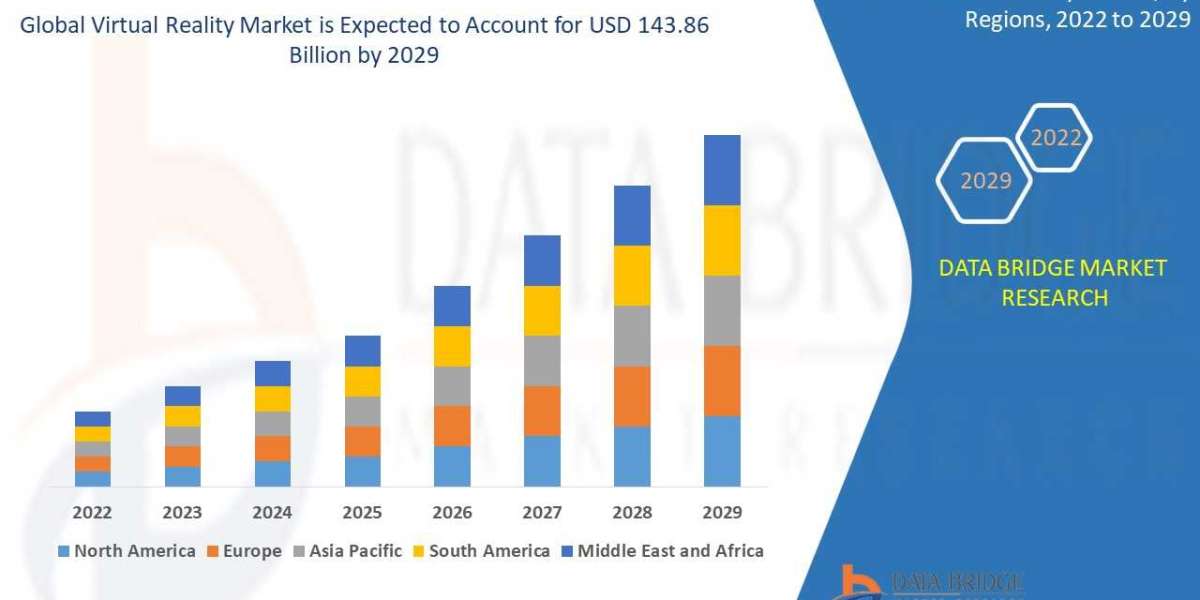"Virtual Reality Market Size And Forecast by 2031
Data Bridge Market Research analyses that the Global Virtual Reality Market which was USD 16.73 Billion in 2021 is expected to reach USD 143.86 Billion by 2029 and is expected to undergo a CAGR of 30.86% during the forecast period of 2021 to 2029
Virtual Reality Market research report provides a comprehensive analysis of the market. The report aims to provide insights into Virtual Reality Market trends, growth opportunities, key drivers and challenges, competitive landscape, and other crucial factors that may impact the market in the forecast period (2024-2031).
Get a Sample PDF of Report - https://www.databridgemarketresearch.com/request-a-sample/?dbmr=global-virtual-reality-market
Which are the top companies operating in the Virtual Reality Market?
The study report on the Global Virtual Reality Market offers a comprehensive analysis of the industry, highlighting key trends, market dynamics, and competitive landscape. It profiles prominent organizations operating in the market, examining their successful strategies and market share contributions. This Virtual Reality Market report provides the information of the Top 10 Companies in Virtual Reality Market in the market their business strategy, financial situation etc.
**Segments**
- **Hardware**: This segment includes devices such as head-mounted displays (HMDs), controllers, sensors, and other peripherals necessary for virtual reality experiences. The demand for advanced and more immersive hardware components is driving growth in this segment as consumers seek more realistic and engaging VR activities.
- **Software**: Virtual reality software encompasses applications, games, and simulations designed to run on VR hardware. With the increasing popularity of VR gaming, education, training, and entertainment applications, the software segment is experiencing rapid expansion. Developers are creating innovative content to enhance the VR experience and attract more users.
- **Content**: The content segment focuses on the creation of immersive and engaging experiences for virtual reality users. This includes 360-degree videos, interactive storytelling, virtual tours, and other content that leverages the unique capabilities of VR technology. As demand for diverse and high-quality VR content grows, content creators and developers are playing a crucial role in shaping the market.
**Market Players**
- **Sony Corporation**: A leading player in the VR market, Sony offers the PlayStation VR headset and a wide range of VR games and experiences for its gaming console. The company's strong brand presence and focus on quality content have helped it capture a significant share of the market.
- **Oculus VR (Facebook)**: Known for its Oculus Rift and Quest VR headsets, Oculus VR is a key player in the VR hardware segment. With a focus on cutting-edge technology and immersive experiences, the company continues to innovate and drive growth in the market.
- **HTC Corporation**: HTC's Vive series of VR headsets are popular among consumers and businesses for their high quality and advanced features. The company's partnerships with content developers and its commitment to VR technology have solidified its position in the market.
- **Google LLC**: Google's Cardboard and Daydream platforms have made VR more accessible to a wider audience. The company's investment in VR content and technologies, such as augmented reality (AR)The virtual reality market is a dynamic and rapidly evolving industry that encompasses various segments such as hardware, software, and content. Each segment plays a crucial role in driving innovation, growth, and adoption of VR technology. In the hardware segment, the demand for more advanced and immersive devices like head-mounted displays (HMDs) and controllers is fueling market growth as consumers seek realistic and engaging VR experiences. Companies like Oculus VR, HTC Corporation, and Sony Corporation are at the forefront of hardware innovation, offering high-quality VR products that cater to a wide range of users.
In the software segment, virtual reality applications, games, and simulations are expanding rapidly, driven by the increasing popularity of VR gaming, education, training, and entertainment. Developers are focusing on creating innovative content to enhance the VR experience and attract more users to the platform. The software segment is crucial in providing a diverse and engaging range of experiences that leverage the full capabilities of VR technology.
The content segment focuses on the creation of immersive and engaging experiences for virtual reality users. This includes 360-degree videos, interactive storytelling, virtual tours, and other content that showcases the unique capabilities of VR technology. As demand for high-quality and diverse VR content grows, content creators are playing a significant role in shaping the market landscape and driving user engagement.
Market players such as Sony Corporation, Oculus VR (Facebook), HTC Corporation, and Google LLC are key influencers in the VR industry. Sony's PlayStation VR headset and VR games have captured a significant share of the market, leveraging its strong brand presence and focus on quality content. Oculus VR, known for its Rift and Quest headsets, continues to innovate in the hardware segment, offering cutting-edge technology and immersive experiences to users worldwide.
HTC Corporation's Vive series of VR headsets are popular among consumers and businesses for their high quality and advanced features. The company's partnerships with content developers and commitment to VR technology have solidified its position in the market. Google LLC, with its Cardboard and Daydream platforms**Market Players**
- Axis Communications AB (Sweden)
- Johnson Controls (Ireland)
- Sony Corporation (Japan)
- Avigilon Corporation (Canada)
- Panasonic Corporation (Japan)
- SAMSUNG (U.S.)
- Arcules, Inc. (U.S.)
- Google LLC (U.S.)
- Microsoft (U.S.)
- HTC Corporation (Taiwan)
- Oculus (U.S.)
- EON Reality (U.S.)
- Vuzix (U.S.)
- CyberGlove Systems Inc. (U.S.)
- Ultraleap, Inc. (U.S.)
- Sixense Enterprises Inc (U.S.)
The virtual reality market is a dynamic and rapidly expanding industry with various segments, including hardware, software, and content. In the hardware segment, companies like Oculus VR, HTC Corporation, and Sony Corporation are driving innovation with advanced devices such as head-mounted displays and controllers to meet the increasing demand for realistic and immersive VR experiences. These market players are continually pushing the boundaries of hardware technology to offer consumers high-quality products that enhance their VR interactions.
In the software segment, the rising popularity of VR applications for gaming, education, training, and entertainment is fueling rapid growth. Developers are creating diverse and innovative content to attract more users to the VR platform, thereby driving adoption and engagement. The software segment plays a critical role in providing a wide range of immersive experiences that leverage the full capabilities of VR technology, enhancing user satisfaction and interest in the market.
Content creators are
Explore Further Details about This Research Virtual Reality Market Report https://www.databridgemarketresearch.com/reports/global-virtual-reality-market
Regional Analysis For Virtual Reality Market
North America (the United States, Canada, and Mexico)
Europe (Germany, France, UK, Russia, and Italy)
Asia-Pacific (China, Japan, Korea, India, and Southeast Asia)
South America (Brazil, Argentina, Colombia, etc.)
The Middle East and Africa (Saudi Arabia, UAE, Egypt, Nigeria, and South Africa)
Why B2B Companies Worldwide Rely on us to Grow and Sustain Revenues:
- Get a clear understanding of the Virtual Reality Market, how it operates, and the various stages of the value chain.
- Understand the current market situation and future growth potential of the Virtual Reality Market throughout the forecast period.
- Strategize marketing, market-entry, market expansion, and other business plans by understanding factors influencing growth in the market and purchase decisions of buyers.
- Understand your competitors’ business structures, strategies, and prospects, and respond accordingly.
- Make more informed business decisions with the help of insightful primary and secondary research sources.
This report provides Global Virtual Reality Market :
- An in-depth overview of the global market for
- Virtual Reality Market Assessment of the global industry trends, historical data from 2015, projections for the coming years, and anticipation of compound annual growth rates (CAGRs) by the end of the forecast period.
- Discoveries of new market prospects and targeted marketing methodologies for Global Virtual Reality Market
- Discussion of RD, and the demand for new products launches and applications.
- Wide-ranging company profiles of leading participants in the industry.
- The composition of the market, in terms of dynamic molecule types and targets, underlining the major industry resources and players.
- The growth in patient epidemiology and market revenue for the market globally and across the key players and Virtual Reality Market segments.
- Study the market in terms of generic and premium product revenue.
- Determine commercial opportunities in the market sales scenario by analyzing trends in authorizing and co-development deals.
Understanding market trends and industry insights at a regional level is essential for effective decision-making. Our reports are available in multiple regional languages to cater to diverse audiences. These localized reports provide in-depth analyses tailored to specific regions, ensuring businesses and stakeholders can access accurate and relevant information. By offering insights in local languages, we aim to bridge communication gaps and empower regional markets with the knowledge they need to grow and thrive. Explore our reports in your preferred language for a more personalized understanding of industry dynamics.
Japanese : https://www.databridgemarketresearch.com/jp/reports/global-virtual-reality-market
Chinese : https://www.databridgemarketresearch.com/zh/reports/global-virtual-reality-market
Arabic : https://www.databridgemarketresearch.com/ar/reports/global-virtual-reality-market
Portuguese : https://www.databridgemarketresearch.com/pt/reports/global-virtual-reality-market
German : https://www.databridgemarketresearch.com/de/reports/global-virtual-reality-market
French : https://www.databridgemarketresearch.com/fr/reports/global-virtual-reality-market
Spanish : https://www.databridgemarketresearch.com/es/reports/global-virtual-reality-market
Korean : https://www.databridgemarketresearch.com/ko/reports/global-virtual-reality-market
Russian : https://www.databridgemarketresearch.com/ru/reports/global-virtual-reality-market
Data Bridge Market Research:
Contact Us:
Data Bridge Market Research
US: +1 614 591 3140
UK: +44 845 154 9652
APAC: +653 1251 1696





















